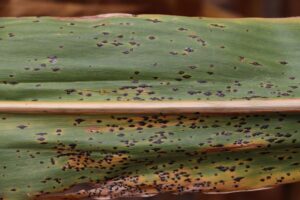Are Fungicides the Answer to Tar Spot?

If tar spot has hit your area—and fungicides aren’t controlling the disease—there’s a reason why. There’s also one key thing you must do to protect your crop.
“In the last three to four years, tar spot has become a major challenge,” said Dr. Don Huber, a professor emeritus of plant pathology at Purdue University. “It’s running rampant in many areas, ranging from low disease pressure to high disease pressure.”
To understand what’s going on with any new or emerging disease, it’s important to look at what has changed. “It will be genetics or environmental conditions,” Huber said.
Tar spot is a fungal disease that causes black specks to form on the leaves. Those black areas aren’t fungal spores; they’re manganese oxide.
“That’s the black stuff that doesn’t rub off the leaf surface,” said Huber, who added that manganese oxide piles up in tar spot-infected areas. “There can be 10,000 to 12,000 parts per million (ppm) of oxidized manganese in these tar spots, which is a phenomenal quantity.”
It’s also common to see a yellow “halo” around the tar spot lesions. In these areas, manganese levels are zero or barely detectable. As tar spot invades plant tissue, it creates a manganese deficiency, which destroys the plant’s ability to photosynthesize. “As tar spot ‘mines’ manganese, the plant goes into an energy deficit,” Huber said. “The disease also diminishes the plants’ ability to defend itself against pathogens.”
Beware of Glyphosate
What has changed that’s allowing tar spot to spread so quickly? Huber cites genetic engineering that has enabled crops’ resistance to glyphosate. To achieve this, plant breeders went back to some older inbreds that were susceptible to some diseases.
This also explains why Goss’s Wilt has become much more of a challenge. “Goss’s Wilt was known for decades before genetic engineering, but it had never moved out of seven counties in eastern Nebraska until recent years,” Huber said.
Glyphosate is a strong chelator that can shut down multiple sources of resistance to diseases, hindering plants’ immune system. “The plant breeders discounted this risk factor,” Huber said.
Glyphosate is stimulating the tar spot pathogen. Glufosinate products like Liberty are in the same category as glyphosate when it comes to the tar spot issue, Huber added. “Some farmers say they can’t give up glyphosate. I say, ‘Good luck controlling tar spot.’”
Feed your crops right
To control tar spot, you need to block the pathway for manganese oxidation. “You can do this with plant nutrition,” Huber said. “Just spraying fungicides won’t solve the tar spot problem.”
Minerals like copper and zinc are essential, since they stimulate antioxidants and inhibit oxidation. “Minerals like zinc make plants more resistant to disease and stress in general,” said Dennis Klockenga, a crops specialist with ProfitProAG. “Manganese, zinc and copper work together to help prevent tar spot.”
Klockenga recommends BioEnergy™+. This foliar feeding system includes a unique blend of sugars, molasses and more to stimulate beneficial soil microbes that help nourish crops. All this boosts the plants’ ability to overcome in-season stresses and maximize the crop’s genetic potential (both yield and quality).
Another key component of BioEnery+ is chitosan, a non-toxic, biodegradable product derived from one of the most abundant organic polymers in nature. Chitosan targets chitin, the main component of insects’ exoskeletons. Harmful fungi and disease pathogens also contain chitin. Chitosan helps break down chitin for greater insect and disease suppression, which promotes healthier crops.
“If we know your crops are susceptible to tar spot, BioEnergy™ +, along with a mix of micronutrients, can be important to boost your crop’s ‘immune system’,” Klockenga said.
Put your soil to the test
Klockenga also encourages farmers to use to key tests, including the Haney test and the BeCrop® Test, to measure biological activity in the soil.
Like traditional soil tests, the Haney test assesses the key macro- and micronutrients needed for crop growth. The Haney test differs from traditional soil tests, however, since it also evaluates various soil health indicators.
The Haney test tracks various soil health indicators, such as soil respiration, to analyze soil biological activity. The Haney test also measures the nutrients that are not locked up in your soil and shows where you have a fertilizer “credit.” This can help you trim your fertilizer bill, since you may not need to apply as much fertilizer as a traditional soil test indicates.
The BeCrop® test is also important, since it sequences strains of DNA to determine what microbes are in your soil. Why does this matter? Beneficial microbes, especially mycorrhizal fungi, are essential in releasing valuable nutrients that are locked up in your soil to make them available to your crop. “Beneficial fungal species break down carbon residue and move it to the soil,” Klockenga explained. “This has to happen before the beneficial bacteria in the soil can release vital nutrients to the plants.”
The BeCrop test helps farmers assess what’s going on in their soil at the microbial level so they can start making improvements, without all the guesswork. “BeCrop provides a user-friendly report on soil nutrient cycling, soil health and microbe biodiversity on any field,” Klockenga said.
Let’s talk
Ready to take control of tar spot? ProfitProAG can help you design a plan tailored to your acres to incorporate the Haney test, the BeCrop test and proper plant nutrition. Contact us for more details.
